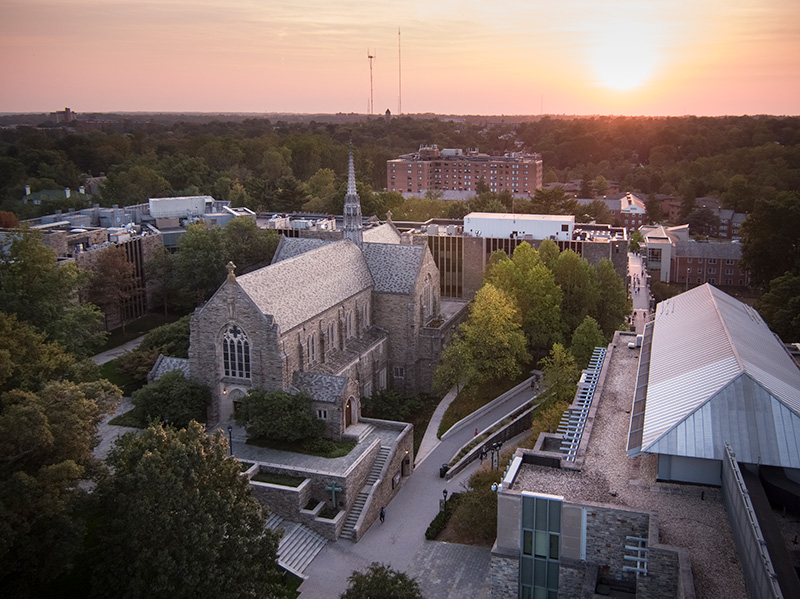Justice
Our Commitment to Social Justice
In his Spiritual Exercises, St. Ignatius identifies the pursuit of holiness, wholeness, and right relationships as the purpose of human existence. Guided by Catholic Social Teaching, this purpose finds expression in Campus Ministry’s commitment to fostering and promoting a more just community. Called to be people for and with others, we are challenged to respond to all forms of individual and systemic injustice in our local, national and global communities. Following the examples of Jesus, St. Ignatius, and other figures in faith and history, Campus Ministry strives to enact a faith that does justice in solidarity with the underrepresented and oppressed. In the spirit of the Ignatian principle of ‘contemplation in action,’ Campus Ministry provides opportunities for students to learn, reflect, pray, dialogue and act.
Social Justice Programs
- The Ignatian Family Teach-In For Justice
- Kino Border Initiative Immersion
- Antiracism through an Ignatian Lens
- IgnatianQ Conference
On Campus Clubs and Groups
- Loyola Alive
- Loyola Environmental Action Club
- Rendez-Vous: Haiti
- Urban Needs in Teacher Education
- York Road Student Association
Walking Examen on Environmental Justice

Image courtesy of Loyola University Maryland, Office of Marketing and Cmmunication
Stop 1: The Chapel
Beginning at the chapel, ask God for guidance and an open mind as you begin your walking examen. Feel grounded in your feet and take a moment to reflect on your surroundings: weather, nature, people.
Stop 2: The Statue of St. Ignatius
Next, start your journey through the quad, towards the statue of St. Ignatius. Ask yourself the following:
- What am I grateful for within my surrounding environment?
- What are the gifts of nature that I take for granted?
- How do my actions impact my environment?
Ignatian spirituality encourages us to be critically aware of the environment in our day to day lives. We are called to be more than mere stewards of the Earth – rather than living as acquaintances with God’s creation, we are called to live in union with it and have a deep commitment to caring for it.
Stop 3: Humanities Building
Once you arrive at humanities, take in the beautiful aesthetic and architecture of the building. Observe the quad. These are the images that represent Loyola; a beautiful, green campus. How should we be acknowledging our privilege of living on a campus like Loyola- where there is clean air, an abundance of greenery, and a safe environment?
Additionally, think about where our quad is situated. As it sits right in the middle of our campus, it reminds us of how the York Road Corridor sits on one side of our campus, while Roland Park sits on the other. Reflect on the following:
- How might these two communities face environmental differences: varying amounts of trees and greenery? Cleaner air vs more polluted air?
- Baltimore has a history of redlining, which is a discriminatory practice designed by white people in power to keep white spaces white and black spaces black through exclusionary lending, denial of financial services, etc. The York Road corridor is a historical redline boundary between the Roland Park and Govans neighborhoods. How do you see the redlining of the two neighborhoods and environmental racism as being correlated? (You can learn more about historical redlining in Baltimore here.)
- Do you feel like you are connected to either community? Or does Loyola remain in a “bubble” that sits between both areas?
Stop 4: Fernandez Center for Innovation and Collaborative Learning (New Building Development)
Continue your journey towards the new building development. While Loyola is a campus with various green initiatives, it also has a very long journey towards becoming a more sustainable campus. Reflect on the following:
- Loyola is a large institution. Think about the mass amounts of fossil fuels, water usage, and waste that results from even a single day of a fully operational university. Consider especially our carbon footprint resulting from this new building development.
- Loyola is a single part of a large city, yet we still have a major impact on our surroundings. How may our actions as a university affect Baltimore City as a whole?
Stop 5: 9/11 Memorial Garden
End your walk at the 9/11 Memorial Garden. Close your eyes and reflect on the peaceful sounds of the water fountain and the nature around you. Water is a precious resource that we often take for granted. Use this water fountain as a symbol to imagine the water usage throughout our university. How might we be more mindful of our usage of such a resource?
Water can also provide a visual of the very real-life effects of climate change. From hurricanes to tsunamis, natural disasters are only becoming more extreme, and they tend to most seriously affect those who are most vulnerable.
Take a moment to reflect on the fact that those who have the largest carbon footprints are those who are least impacted by the effects of climate change, and those who have the smallest carbon footprints are those who are most impacted by its effects.
Ending Your Examen
After reflecting throughout your walking Examen, think about how you might put your thoughts into action to move towards creating a more sustainable environment for our Earth. What are 1-2 concrete steps you can take as an individual to become a more conscious steward of the resources available to you?
The Examen is an ongoing experience that can be carried out throughout your day. We invite you to continue walking and reflecting if you feel compelled to. Mindfulness throughout our everyday interactions (I.e., walking through the quad) can be a way for us to open ourselves up to the gifts God shares with us each day